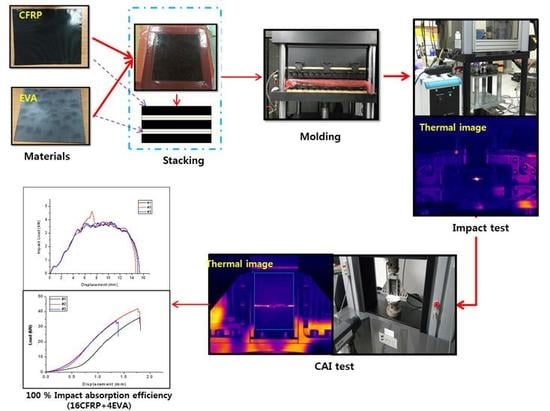Correlation between Drop Impact Energy and Residual Compressive Strength According to the Lamination of CFRP with EVA Sheets
Abstract
:1. Introduction
2. Materials and Methods
2.1. Specimen Preparation
2.2. Drop Weight Impact and Compression after Impact Test
3. Results and Discussion
3.1. Drop Impact Test Results
3.2. Compression after Impact Test Results
4. Conclusions
- The drop impact test on CFRP laminated with EVA showed that there was no significant difference in the impact absorption efficiencies when two sheets of highly flexible EVA were laminated. However, the Type 3 specimen laminated with four sheets of EVA demonstrated an impact absorption efficiency of 100%. In addition, it was confirmed that there was no significant difference between CFRP laminated with EVA sheets on the outside and inside. The thermal energy generated during the impact was proportional to the impact load. In the thermal images taken during impact, the behavior of the puncture mode was observed as the number of laminated EVA sheets increased.
- As a result of the CAI test conducted to measure the residual compressive strength of the test specimen after the drop impact test, 50% to 30% of the strength was reduced compared to the original compressive test specimen. A higher number of EVA layers resulted in lower CAI strength values.
- Thermal images were acquired and analyzed to assess the failure mode and thermal characteristics of the drop impact test and the CAI test. With the CAI specimens, it was difficult to identify an apparent tendency because random damage was already generated due to the drop impact. However, the impact mode and the direction of crack propagation were confirmed by analyzing the images. SEM image observation showed that the CFRP was prone to large fracture damage, whereas the EVA sheets tended to slow the fracture of the composites during the testing.
- The study results confirmed that the application of EVA sheets, with excellent flexibility, to the carbon composite materials is helpful in mitigating external impact. However, the results may vary depending on the lamination conditions of EVA sheets. By selecting the optimal conditions through prior review, carbon composite materials can be applied for impact mitigation. In this study, it was found that, based on EVA sheets, the composite Type 3 is the optimum structure for high-impact energy absorption efficiency with good compression strength.
Author Contributions
Funding
Acknowledgments
Conflicts of Interest
References
- Richardson, M.O.W.; Wisheart, M. Review of Low-Velocity Impact Properties of Composite Materials. Compos. Part A 1996, 27, 1123–1131. [Google Scholar] [CrossRef]
- Serge, A. Impact on Composite Structure; Cambridge University Press: Cambridge, UK, 1998. [Google Scholar]
- Davies, G.A.O.; Zhang, X. Impact Damage Prediction in Carbon Composite Structure. Int. J. Impact Eng. 1995, 16, 149–170. [Google Scholar] [CrossRef]
- Han, J.W. Low-Velocity Impact Characterization of Laminated Composite Materials. J. Korean Soc. Saf. 2008, 23, 24–27. [Google Scholar]
- Byun, J.I.; Kim, J.Y.; Heo, S.B.; Kim, H.S. Study on Simulation Characteristics of Low Velocity Impact Test of Carbon/Epoxy Composites Plates Manufactured by Filament Winding Method. Trans. Korean Hydrog. New Energy Soc. 2018, 29, 190–196. [Google Scholar]
- Go, S.H.; Kim, H.G.; Shin, H.J.; Lee, M.S.; Yoon, H.G.; Kwac, L.K. The Impact Fracuture Behaviors of CFRP/EVA Composites by Drop-Weight Impact Test. Carbon Lett. 2017, 21, 23–32. [Google Scholar] [CrossRef] [Green Version]
- Li, Y.; Zhang, W.; Yang, Z.W.; Zhang, J.Y.; Tao, S.J. Low-Velocity Impact Damage Characterization of Carbon Fiber Reinforced Polymer (CFRP) using Infrared Thermography. Infrared Phys. Technol. 2016, 76, 91–102. [Google Scholar] [CrossRef] [Green Version]
- Kang, D.H.; Seo, M.Y.; Gimm, H.; Kim, T.W. Determination of Shock Absorption Performance and Shear Modulus of Rubbers by Drop Impact Test. Trans. Korean Soc. Mech. Eng. A 2009, 33, 321–328. [Google Scholar] [CrossRef] [Green Version]
- Salvetti, M.; Gilioli, A.; Sbarufatti, C.; Dragan, K.; Chalimoniuk, M.; Manes, A.; Giglio, M. Analytical Model to Describe Damage in CFRP Specimen when Subjected to Low Velocity Impacts. Procedia Eng. 2016, 167, 2–9. [Google Scholar] [CrossRef]
- Kaybal, H.B.; Ulus, H.; Demir, O.; Sahin, O.S.; Avci, A. Effects of Alumina Nanoparticles on Dynamic Impact Responses of Carbon Fiber Reinforced Epoxy Matrix Nanocomposites. Eng. Sci. Technol. Int. J. 2018, 21, 399–407. [Google Scholar] [CrossRef]
- Daelemans, L.; Cohades, A.; Meireman, T.; Beckx, J.; Spronk, S.; Kersemans, M.; Baere, I.D.; Rahier, H.; Michaud, V.; Paepegem, W.V.; et al. Electrospun Nanofibrous Interleaves for Improved Low Velocity Impact Resistance of Glass Fibre Reinforced Composite Laminates. Mater. Des. 2018, 141, 170–184. [Google Scholar] [CrossRef]
- Li, Z.; Khennane, A.; Hazell, P.J.; Brown, A.D. Impact Behaviour of Pultruded GFRP Composites under Low-Velocity Impact Loading. Compos. Struct. 2017, 168, 360–371. [Google Scholar] [CrossRef]
- Riccio, A.; Luca, A.D.; Felice, G.D.; Caputo, F. Modelling the Simulation of Impact Induced Damage onset and Evolution in Composites. Compos. Part B 2014, 66, 340–347. [Google Scholar] [CrossRef]
- Joo, H.J.; Son, J.S. The Impact Fracture Behaviors of Low Density 2-D Carbon/Carbon Composites by Drop Weight Impact Test. Polym. Korea 2002, 26, 270–278. [Google Scholar]
- Suh, Y.W.; Woo, K.S.; Choi, I.H.; Kim, K.T.; Ahn, S.M. Analysis of Low Velocity Impact Damage and Compresive Strength After Impact for Laminated Composites. KARI 2011, 10, 183–192. [Google Scholar]
- Goo, J.S.; Shin, K.B.; Kim, J.S. Evaluation of Impact Damage and Residual Compression Strength after Impact of Glass/Epoxy Laminate Composites for Lightweight Bogie Frame Induced by Ballast-Flying Phenomena. J. Korean Soc. Railw. 2012, 15, 109–115. [Google Scholar] [CrossRef] [Green Version]
- Remacha, M.; Sanchez-Saez, S.; Lopez, B.; Barbero, E. A Noe Device for Determining the Compression After Impact Strength in Thin Laminates. Compos. Struct. 2015, 127, 99–107. [Google Scholar] [CrossRef] [Green Version]
- Falaschetti, M.P.; Scafe, M.; Troiani, E.; Agostinelli, V.; Sangiorgi, S. Experimental Determination of Compressive Residual Strength of a Carbon/Epoxy Laminate after a Near-Edge Impact. Procedia Eng. 2015, 109, 171–180. [Google Scholar] [CrossRef] [Green Version]
- Lopresto, V.; Langella, A.; Papa, I. Residual Strength Evaluation after Impact Tests in Extreme Conditions on CFRP Laminates. Procedia Eng. 2016, 167, 138–142. [Google Scholar] [CrossRef]
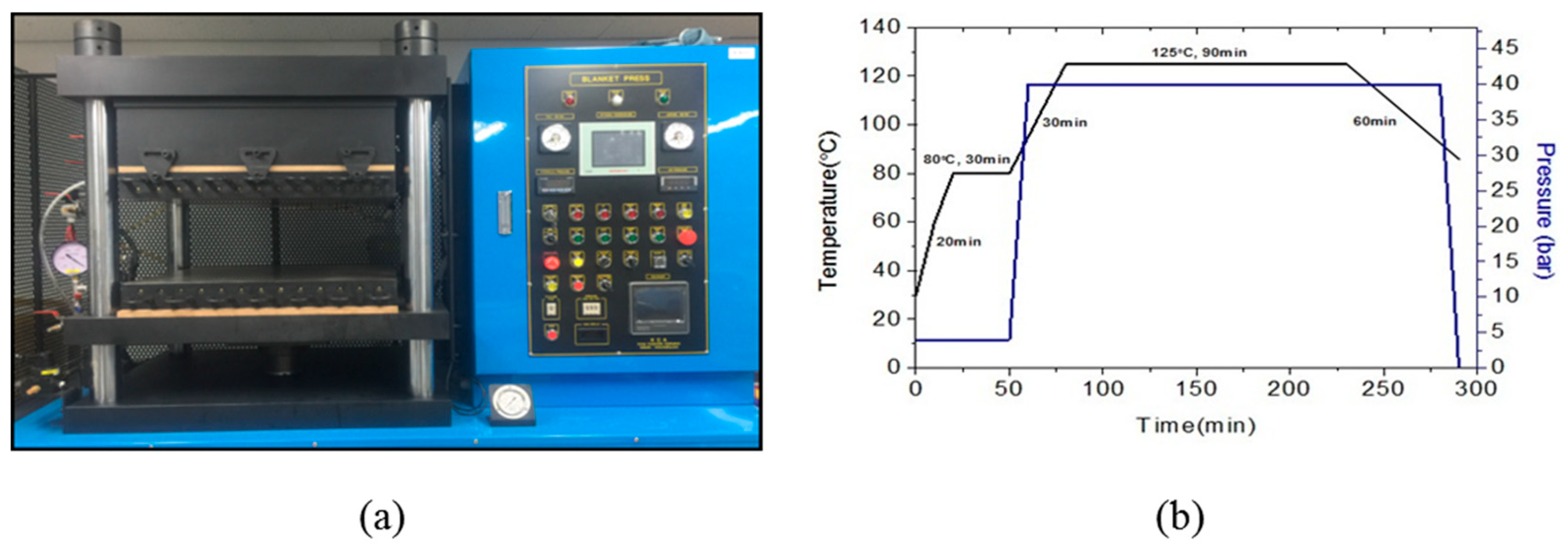

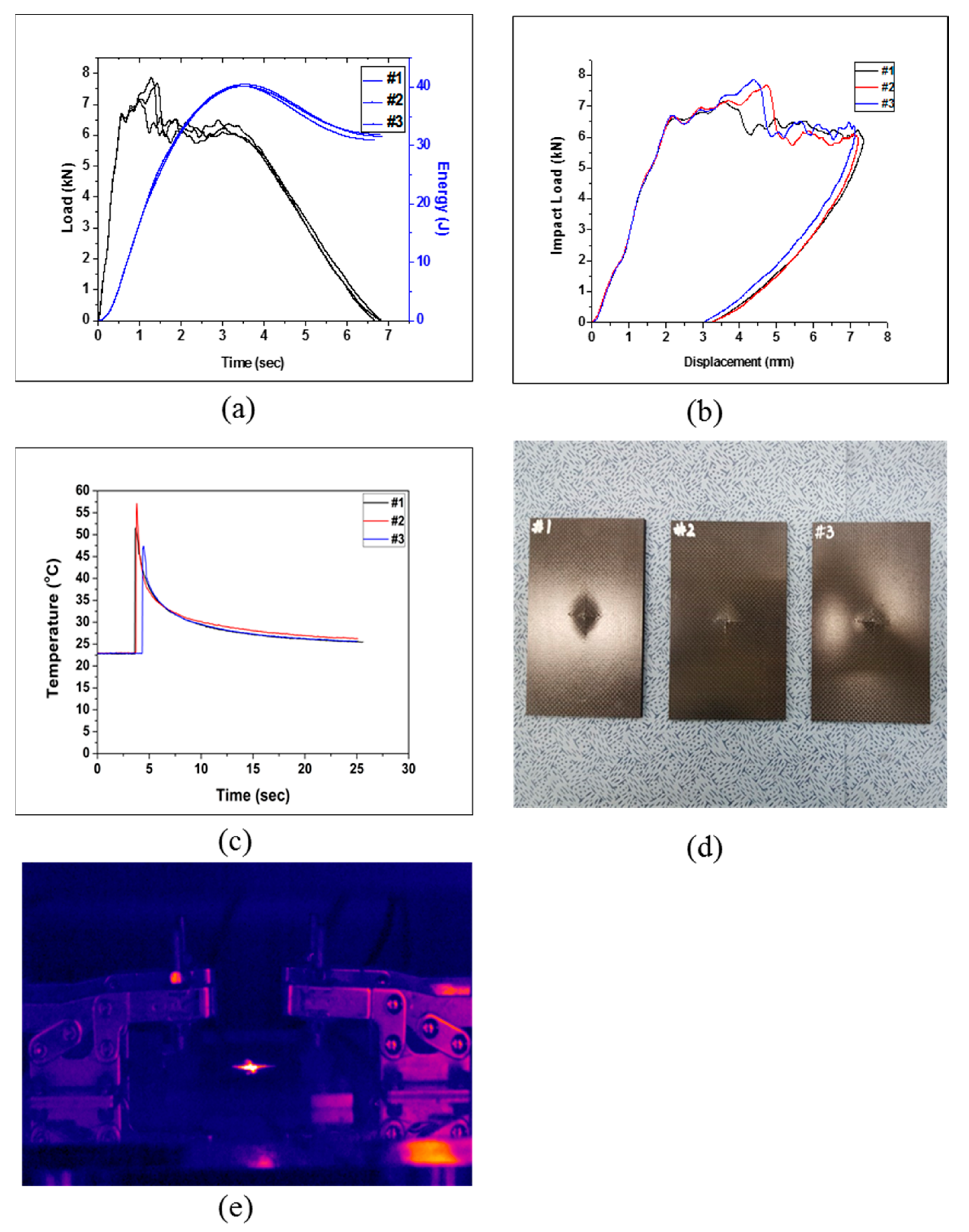
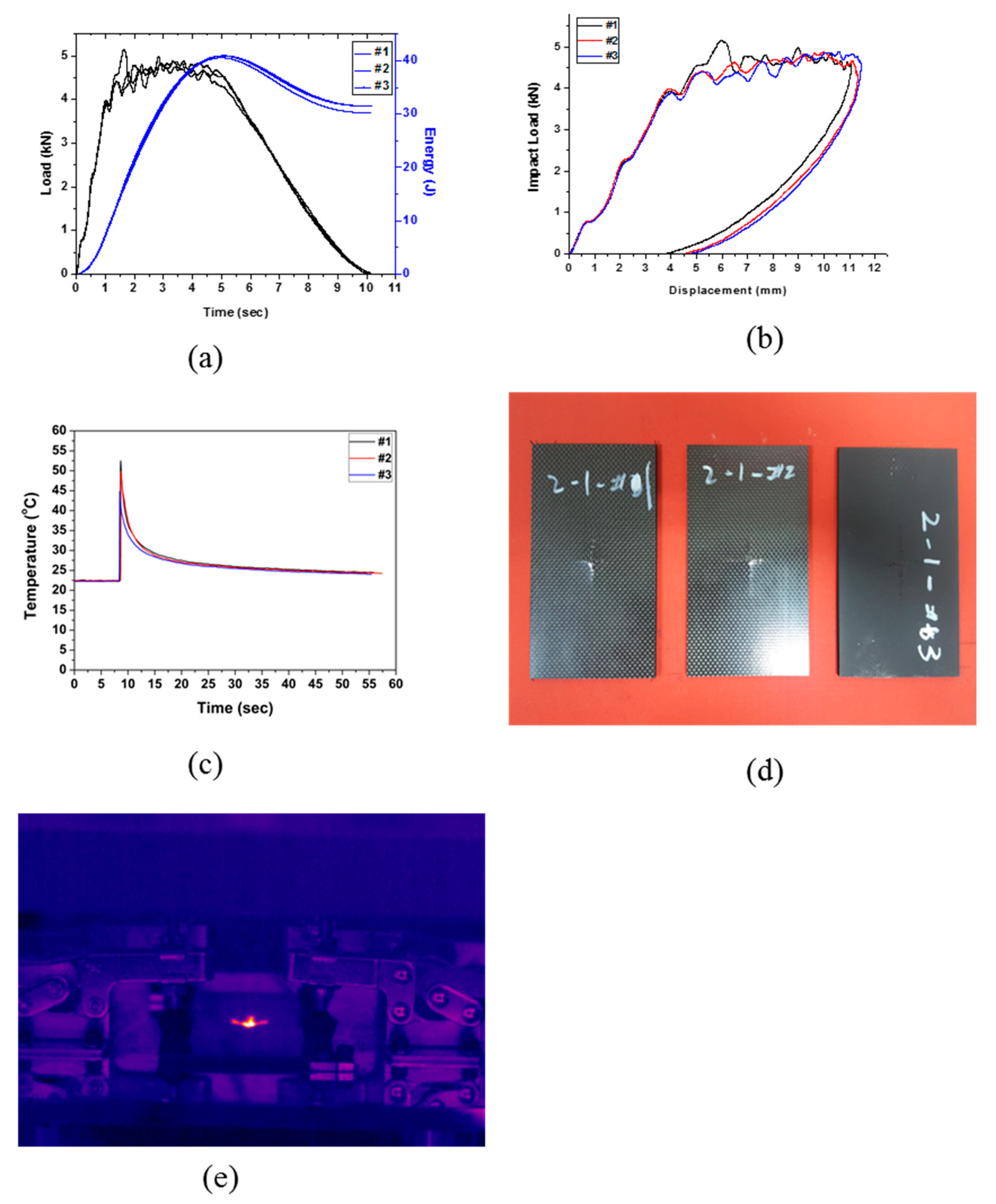

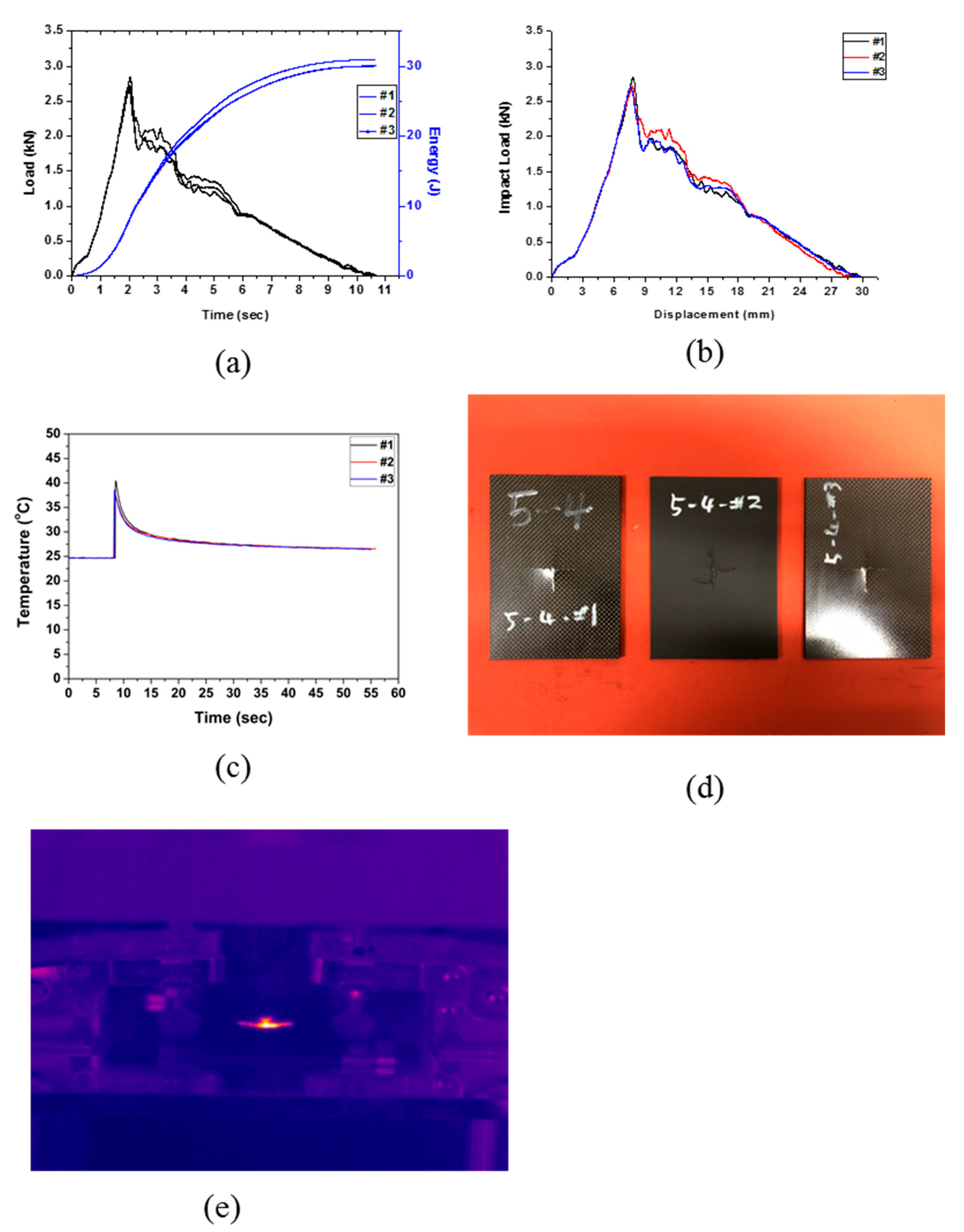


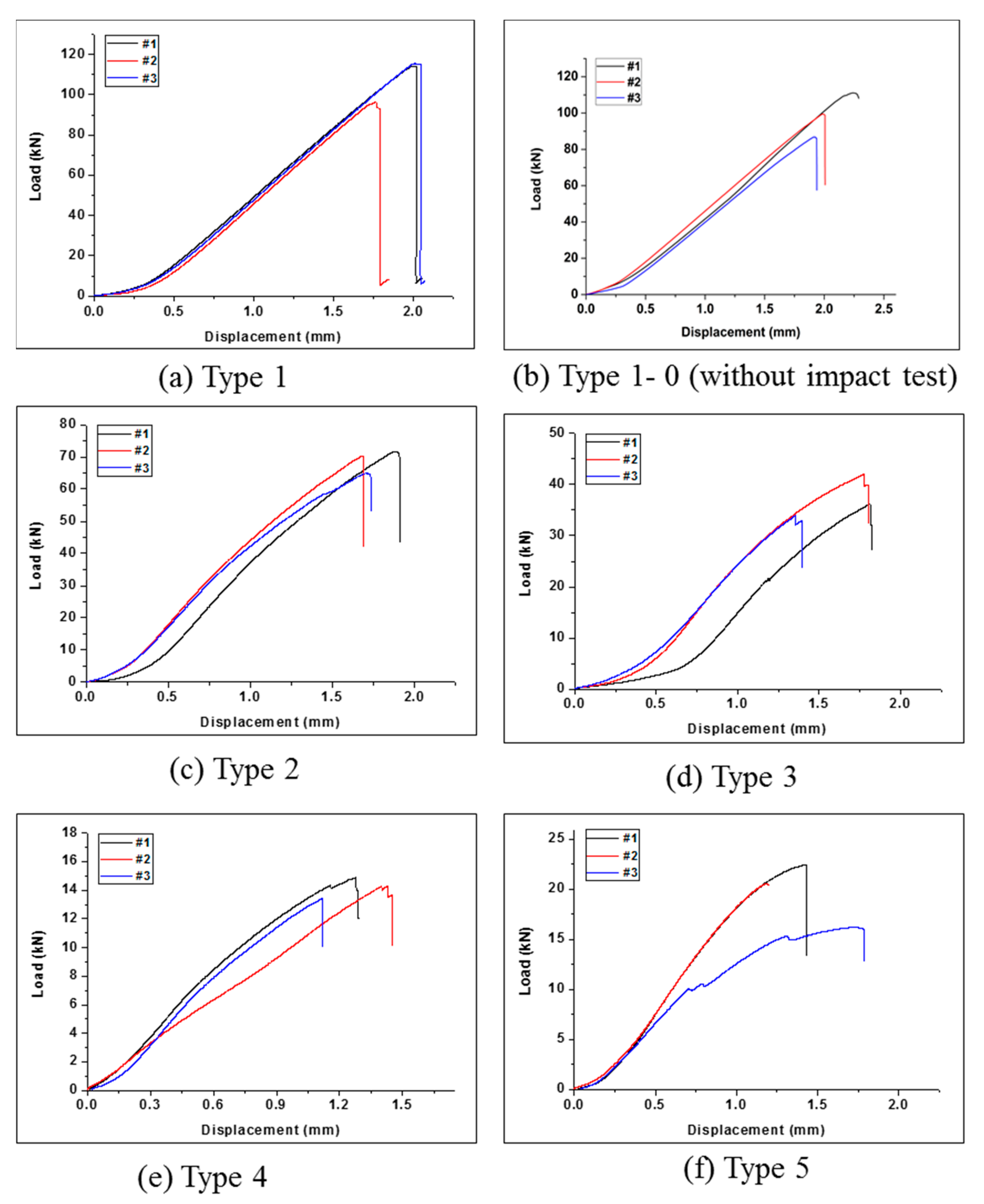
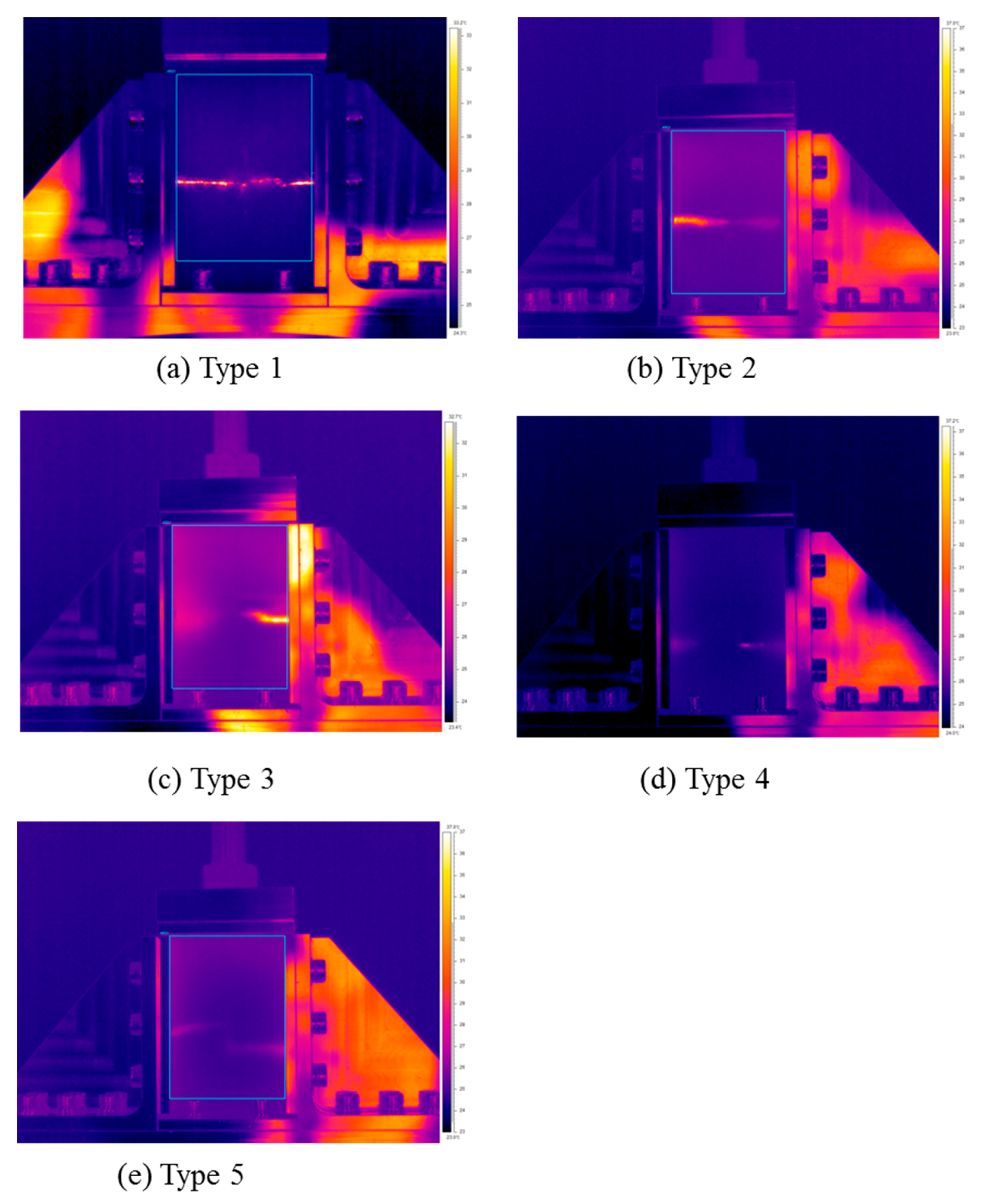

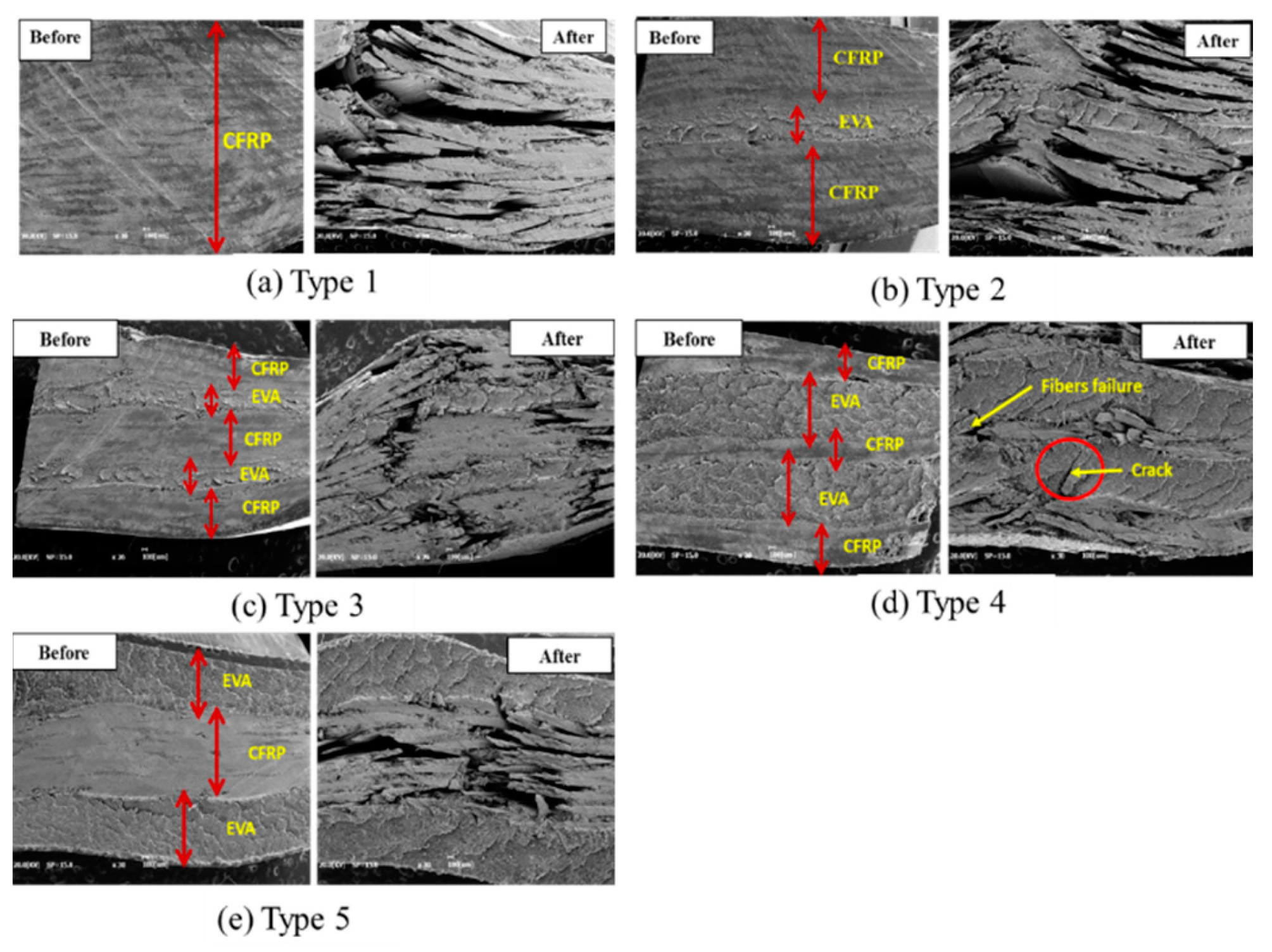
| Thickness (mm) | Fiber Areal Weight (g/m2) | Resin Content (%) | Total Weight (g/m2) |
|---|---|---|---|
| 0.227 | 240 | 41 | 336 |
| VA Content (%) | Weight | Tensile Strength (kg/cm2) | Elongation (%) |
| 33 | 0.96 | 85 | 800 |
| Tensile Modulus (kg/cm2) | Hardness | Softening Point (Vicat, °C) | Thickness (mm) |
| 900 | 60 | Below 40 | 0.45 |
| Type 1 | Type 2 | Type 3 | Type 4 | Type 5 |
|---|---|---|---|---|
| 24 (CFRP) | 20 (CFRP):2 (EVA) | 16 (CFRP):4 (EVA) | 8 (CFRP):8 (EVA) | 8 (CFRP):8 (EVA) |
 |  |  |  |  |
| Impact Velocity (m/s) | Drop Weight (kg) | Impact Energy (J) | Test Height (m) | Room Temperature (°C) |
|---|---|---|---|---|
| 3.92 | 5.219 | 39.96 | 0.79 | +23 ± 2 |
| # | Impact Maximum Load (kN) | Impact Energy at Maximum. Load (J) | Absorbed Energy (J) | Impact Absorption Efficiency (%) | Maximum Temperature (°C) |
|---|---|---|---|---|---|
| 1 | 7.14 | 40.47 | 31.59 | 78.06 | 51.73 |
| 2 | 7.69 | 40.15 | 31.95 | 79.56 | 57.13 |
| 3 | 7.85 | 40.22 | 30.97 | 77.01 | 47.40 |
| Average | 7.56 | 40.28 | 31.50 | 78.21 | 52.09 |
| SD | 0.30 | 0.14 | 0.40 | 1.05 | 3.98 |
| # | Impact Maximum Load (kN) | Impact Energy at Maximum Load (J) | Absorbed Energy (J) | Impact Absorption Efficiency (%) | Maximum Temperature (°C) |
|---|---|---|---|---|---|
| 1 | 5.16 | 40.57 | 30.21 | 74.44 | 52.49 |
| 2 | 4.88 | 40.97 | 31.48 | 76.85 | 49.91 |
| 3 | 4.89 | 40.91 | 31.49 | 76.98 | 44.84 |
| Average | 4.97 | 40.82 | 31.06 | 76.09 | 49.08 |
| SD | 0.13 | 0.17 | 0.60 | 1.17 | 3.18 |
| # | Impact Maximum Load (kN) | Impact Energy at Maximum Load (J) | Absorbed Energy (J) | Impact Absorption Efficiency (%) | Maximum Temperature (°C) |
|---|---|---|---|---|---|
| 1 | 3.74 | 41.05 | 41.05 | 100.00 | 41.75 |
| 2 | 4.61 | 41.25 | 41.24 | 99.99 | 45.48 |
| 3 | 3.85 | 40.86 | 40.86 | 100.00 | 45.19 |
| Average | 4.07 | 41.05 | 41.05 | 100.00 | 44.14 |
| SD | 0.38 | 0.16 | 0.16 | 0.00 | 1.70 |
| # | Impact Maximum Load (kN) | Impact Energy at Maximum Load (J) | Absorbed Energy (J) | Impact Absorption Efficiency (%) | Maximum Temperature (°C) |
|---|---|---|---|---|---|
| 1 | 2.85 | 30.04 | 30.04 | 100.00 | 40.44 |
| 2 | 2.72 | 30.91 | 30.91 | 100.00 | 38.11 |
| 3 | 2.69 | 30.01 | 30.01 | 100.00 | 38.60 |
| Average | 2.75 | 30.32 | 30.32 | 100.00 | 39.05 |
| SD | 0.07 | 0.42 | 0.42 | 0.00 | 1.01 |
| # | Impact Maximum Load (kN) | Impact Energy at Maximum Load (J) | Absorbed Energy (J) | Impact Absorption Efficiency (%) | Maximum Temperature (°C) |
|---|---|---|---|---|---|
| 1 | 2.55 | 27.91 | 27.91 | 100.00 | 28.29 |
| 2 | 2.22 | 27.85 | 27.85 | 100.00 | 29.21 |
| 3 | 2.26 | 28.23 | 28.23 | 100.00 | 28.42 |
| Average | 2.34 | 28.00 | 28.00 | 100.00 | 28.64 |
| SD | 0.14 | 0.16 | 0.16 | 0.00 | 0.41 |
| # | Area (mm2) | Load (kN) | Compressive Residual Strength (MPa) | Maximum Temperature (°C) |
|---|---|---|---|---|
| 1 | 520.73 | 114.24 | 219.39 | 58.82 |
| 2 | 520.57 | 96.36 | 185.10 | 42.87 |
| 3 | 524.41 | 115.60 | 220.44 | 48.25 |
| Average | 519.93 | 100.88 | 208.31 | 49.98 |
| SD | 4.33 | 18.00 | 20.10 | 8.11 |
| # | Area (mm2) | Load (kN) | Compressive Residual Strength (MPa) | Maximum Temperature (°C) |
|---|---|---|---|---|
| 1 | 425.67 | 111.12 | 261.05 | 58.82 |
| 2 | 426.82 | 99.48 | 233.07 | 42.87 |
| 3 | 419.64 | 86.82 | 206.89 | 48.25 |
| Average | 424.04 | 99.14 | 233.67 | 49.98 |
| SD | 3.86 | 12.15 | 27.08 | 8.11 |
| # | Area (mm2) | Load (kN) | Compressive Residual Strength (MPa) | Maximum Temperature (°C) |
|---|---|---|---|---|
| 1 | 474.81 | 71.66 | 150.92 | 34.70 |
| 3 | 473.51 | 70.18 | 148.21 | 37.77 |
| 3 | 474.51 | 65.00 | 136.98 | 41.46 |
| Average | 474.28 | 68.95 | 145.37 | 37.97 |
| SD | 0.68 | 3.50 | 7.39 | 3.39 |
| # | Area (mm2) | Load (kN) | Compressive Residual Strength (MPa) | Maximum Temperature (°C) |
|---|---|---|---|---|
| 1 | 431.29 | 36.18 | 83.89 | 41.10 |
| 2 | 434.91 | 41.98 | 96.53 | 42.78 |
| 3 | 437.44 | 33.90 | 77.50 | 33.61 |
| Average | 434.54 | 37.35 | 85.97 | 39.16 |
| SD | 3.09 | 4.17 | 9.68 | 4.88 |
| # | Area (mm2) | Load (kN) | Compressive Residual Strength (MPa) | Maximum Temperature (°C) |
|---|---|---|---|---|
| 1 | 416.75 | 14.88 | 35.70 | 35.03 |
| 2 | 413.04 | 14.28 | 34.57 | 35.93 |
| 3 | 415.75 | 13.40 | 32.23 | 34.13 |
| Average | 415.18 | 14.19 | 34.17 | 35.03 |
| SD | 1.92 | 0.74 | 1.77 | 0.90 |
| # | Area (mm2) | Load (kN) | Compressive Residual Strength (MPa) | Maximum Temperature (°C) |
|---|---|---|---|---|
| 1 | 400.20 | 22.46 | 56.12 | 31.52 |
| 2 | 401.88 | 20.58 | 51.21 | 28.17 |
| 3 | 403.68 | 16.24 | 40.23 | 29.34 |
| Average | 401.92 | 19.76 | 49.19 | 29.70 |
| SD | 1.74 | 3.19 | 8.14 | 1.73 |
© 2020 by the authors. Licensee MDPI, Basel, Switzerland. This article is an open access article distributed under the terms and conditions of the Creative Commons Attribution (CC BY) license (http://creativecommons.org/licenses/by/4.0/).
Share and Cite
Go, S.-H.; Lee, M.-S.; Hong, C.-G.; Kwac, L.-K.; Kim, H.-G. Correlation between Drop Impact Energy and Residual Compressive Strength According to the Lamination of CFRP with EVA Sheets. Polymers 2020, 12, 224. https://doi.org/10.3390/polym12010224
Go S-H, Lee M-S, Hong C-G, Kwac L-K, Kim H-G. Correlation between Drop Impact Energy and Residual Compressive Strength According to the Lamination of CFRP with EVA Sheets. Polymers. 2020; 12(1):224. https://doi.org/10.3390/polym12010224
Chicago/Turabian StyleGo, Sun-Ho, Min-Sang Lee, Chang-Gi Hong, Lee-Ku Kwac, and Hong-Gun Kim. 2020. "Correlation between Drop Impact Energy and Residual Compressive Strength According to the Lamination of CFRP with EVA Sheets" Polymers 12, no. 1: 224. https://doi.org/10.3390/polym12010224




